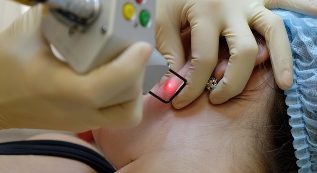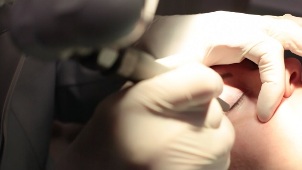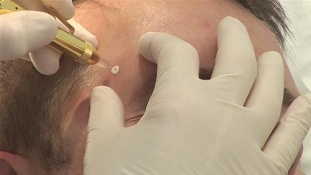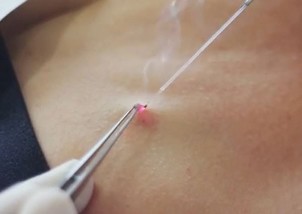
Laser removal of neoplasms is a very common and effective procedure that helps get rid of unwanted growths. This is a relatively new method, which appeared in the medical arsenal not too long ago, but has already managed to prove its superiority over other methods of lifting. The precursor to laser destruction is removal using liquid nitrogen, electricity, or a scalpel. All of these can cause considerable discomfort to the patient, while laser removal shows high yield with painless interventions.
Why delete
Papillomas, which come in all shapes and sizes, are usually benign neoplasms. They are localized on the mucous membranes of the wearer or their skin. The main reason for their appearance is the action of the human papillomavirus, in most cases it is sexually transmitted.
Removing this build-up does multiple tasks at once:
- Aesthetic correction.A patient with growth may feel uncomfortable with excessive attention from others. Because of this, a person may feel insecure and uncomfortable, even if the growth does not harm him.
- Injury prevention.If the growth is in a traumatic site where the patient is constantly touching it, this can cause separation of the protruding part. Also, when trying to cover the papilloma with clothing, there may be problems such as rubbing the affected area. It is fraught with sores on the papilloma and possible subsequent infection. This damage can lead to penetration of microbes that can cause inflammation of the wound. If this happens, the damaged area should be treated with peroxide and immediately go to the clinic to remove the remaining papilloma.
- Reduces cancer risk.Despite the fact that the growths are benign, their wart-like manifestations are very diverse. They are usually in an intimate setting and pose a great danger in terms of cancer development. To prevent disease, all warts must be removed.
Don't erase your own growth. Any attempt to tie the papilloma with thread, comb it, put some kind of chemical on it can worsen the condition.
Benefits of the procedure
Laser destruction has several advantages over other disengagement methods.These include:
- Guaranteed results.Thanks to the laser effect, the growth is completely lost, leaving nothing even in the deep subcutaneous layer. The device is capable of penetrating deep enough to clear all traces of the neoplasm.
- Pain.Laser exposure provides minimal pain to the patient. If you add preliminary anesthesia to the procedure under local anesthesia, there is no pain at all.
- Procedure speed. Removing papillomas by laser takes 2 to 5 minutes per element.
- Non-invasive.The laser beam is in a very limited area and does not go beyond it. In this case, more than one laser part does not touch the procedure site. This is very important because this method helps minimize the risk of infection and provides a guarantee of high infertility.
- No postoperative scars.If the job is done correctly, there should be no trace of the laser action on the exposure site. This is due to the fact that the affected tissue is completely evaporated, and then replaces it with new, intact skin.
- How to remove bloodless.The laser beam heats up the capillaries that supply blood, rapidly closing their walls. As a result, bleeding stopped and did not continue after surgery.
- Suitable for different parts of the body.Not all removal methods can be used on every part of the body. Intimate place, eyelids, etc. Is considered very sensitive. Laser crushing works well with buildup in such areas due to the precision of the laser beam.
All of these factors make laser removal one of the most popular procedures for growth removal.
Contraindications
The list of contraindications for this procedure is not over other methods of destruction.Among the laser removal prohibitions:
- diabetes mellitus;
- oncology;
- exacerbation of chronic diseases;
- epilepsy;
- diseases associated with endocrine system problems;
- poor blood clotting;
- HIV or AIDS;
- acute inflammatory disease.
In addition, patients who have recently had influenza or an acute respiratory infection should also postpone the procedure for some time.
Procedure description
Before starting any procedure to remove growths, the doctor will disinfect the area to be operated on. In some cases, local anesthesia is used. Usually, ointments or sprays are used for this. After applying the anesthetic, 2-3 minutes pass, and the removal process begins.

A laser beam is directed at the affected area and, as it were, incinerated any unwanted growth. At this time, the cell contents are evaporated under the influence of a laser, removing any layers of affected tissue. This happens not only in easily accessible places in open spaces. The procedure for removing papillomas, for example on the eyelids, is the same. The only nuance of this area is the special cooling method the patient uses to prevent pain and burns at this sensitive point.
Neoplasms in intimate places are removed according to the same principle. But here the doctor usually uses an anesthetic injection as an anesthetic, injecting growths from different sides.
When inserting the needle it can be a bit painful, but after a few minutes the sensitivity in the area of influence completely disappears, and further manipulation is completely painless.
The affected area turned into a small, bloodless wound. At the time of crushing, it is disinfected due to laser work. After removing the buildup, the doctor treats the affected area with potassium permanganate.
After the procedure, the patient may experience some redness, itching or mild pain at the papilloma removal site.
This reaction is considered normal, because although the procedure is not invasive, during the operation there is a disturbance in the integrity of the skin.All discomfort will completely disappear 2-4 days after the procedure.
Dry crust later appears over the wound. Underneath is a layer of skin that is already healthy, so that the protective shell cannot come off until it falls off on its own. Otherwise, scars may remain on the skin, and the healing process itself may take longer.
Consequences
Complications after laser damage are rare. Usually, their presence is associated with a disease already suffered by the patient, which he did not cure before the procedure. So, for example, if a patient has skin inflammation, it can cause pigmentation to appear. If the skin itself is very sensitive, a slight redness associated with the burn may occur. With a high allergic reaction, edema may occur at the site of exposure.
To exclude all unintended consequences, you need to consult a doctor before performing laser destruction.
After-procedure care
After removing the build-up, patients must adhere to the following rules:
- do not let water get into the wound for 2-3 days;
- refrain from visiting saunas, baths and swimming pools;
- do not rub the damaged area with a towel;
- do not use adhesive tape on wounds;
- do not treat the papilloma removal site with scrubs, lotions, containing alcohol;
- Avoid exposure to ultraviolet rays.
Several times a day, it is necessary to apply antiseptic treatment to the wound. This should be done until the scab is removed. This treatment should prevent infection and help speed up the complete healing time.For the treatment of damaged areas, you can drink iodine or potassium permanganate solution.
After the removal site can be treated with anti-inflammatory ointments.
Their action is aimed at accelerating tissue regeneration, reducing inflammation and edema. Before choosing a particular treatment, it is best to consult a doctor.
Which method is better
Laser removal is not the only way to treat unwanted growth. There are also other ways, among which they stand out:

Cryodestruction.
Based on the removal of papillomas with liquid nitrogen. Due to exposure to low temperatures, the buildup begins to collapse and eventually disappears completely. This method is effective, but has several drawbacks. Among them, the impossibility of complete control over the depth of action of nitrogen. The substance can pass very deep, touch healthy areas, or, conversely, affect only superficially, without affecting all layers of build-up localization.
Also, these methods are characterized by:
- possible postoperative scar;
- painful sensations;
- inability to guarantee results after the first procedure.
So laser crushing shows greater efficiency compared to cryodestruction. Laser removal is less painful and is more likely to guarantee the desired result.
Elimination of radio waves.
This method of destruction is performed using special equipment that acts on the papilloma via radio waves. This promotes buildup excision due to the radio knife point effect. The accuracy of the procedure is very high, so that the surrounding tissue is not affected. However, the risk of burns or infection is very low.
This method is suitable for removing small benign lesions. It is very efficient, which has made it popular as a laser destroyer. Both methods are considered modern approaches to removing papillomas and are equally well used in medicine.

Electrocoagulation.
This method is based on the action of high-frequency electric currents affecting the papilloma directly at the site of the lesion. Electrocoagulation is now considered a common method but is out of date. This method allows you to prevent bleeding after papilloma removal by burning the blood vessels.
However, when using high-frequency currents, the patient experiences pain that appears even after anesthesia. This has led some patients to abandon electrocautery, choosing laser removal as the more advanced and painless method.
Estimated cost
The price range depends not only on the region and clinic where the deletion was performed, but also on the number, size and location of growth removed.
In many clinics, there is a discount for eliminating new growths en masse: the more patients have, the cheaper it will be to eliminate a single growth.
Removing growths on the genital area can be much more expensive than on the rest of the body. In addition, not all clinics provide such services due to the complexity of the manipulation.














































































